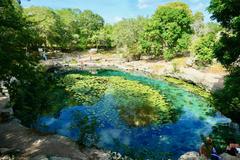Visiting Monumento A La Patria in Mérida, Mexico: A Complete Guide
Date: 18/08/2024
Introduction
The Monumento a la Patria in Mérida, Yucatán, Mexico, is an iconic landmark that offers a profound insight into the rich cultural heritage and history of Mexico. Situated at the northern end of the city’s famous Paseo de Montejo, this monumental stone structure is a blend of artistic beauty and historical significance. Designed by Colombian sculptor Rómulo Rozo, the monument was inaugurated in 1956, after 11 years of intricate hand-carving work (Mexican Routes). It stands as a testament to the Mexican homeland, capturing the essence of various epochs from pre-Columbian civilizations to the modern era. This guide delves into the monument’s historical background, artistic and architectural details, visitor information, and more, offering a comprehensive overview for anyone planning to visit this remarkable site.
Table of Contents
Historical Background
Construction and Inception
The Monumento a la Patria in Mérida is a monumental stone structure erected in the mid-20th century to honor the Mexican homeland. The construction began on March 7, 1945, under the direction of Colombian sculptor Rómulo Rozo, with the collaboration of architect Manuel Amábilis Domínguez, his son Max Amábilis, and master builder Víctor Nazario Ojeda. Initially, the monument was intended to be dedicated solely to the Mexican flag. However, the scope was later expanded to graphically represent the comprehensive history of Mexico, making it one of the few structures in the country to fulfill such a purpose.
Due to the complexity and intricacy of the work, the construction spanned 11 years, culminating in its completion in 1956. The monument was officially inaugurated on April 23, 1956, by then-President of Mexico, Adolfo Ruiz Cortines. In 2016, the International Bureau of Cultural Capitals recognized the Monumento a la Patria as one of Mérida’s Cultural Treasures and as part of the cultural emblems of humanity.
Artistic and Architectural Details
The Monumento a la Patria is renowned for its unique architectural style, which blends Art Deco with Neo-Maya indigenist elements. The entire structure is hand-carved from cantera stone, a type of volcanic rock commonly used in Mexican architecture. The monument features a central hemicycle flanked by two ramps, a staircase, and a fountain. It stands 14 meters tall and spans 40 meters in diameter, covering a surface area of 2,500 square meters.
The monument showcases over 300 hand-carved figures that depict the history of Mexico from the founding of Tenochtitlán in the pre-Hispanic era to significant events in the first half of the 20th century. The front of the monument prominently features a kneeling female figure with mestizo features, adorned in Mayan attire and jewelry, including a jade necklace shaped like a conch shell. This figure holds a banner bearing the Mexican flag, symbolizing the nation’s sovereignty.
Symbolism and Historical Representation
The Monumento a la Patria is rich in symbolism, with various elements representing different aspects of Mexican history and culture. The front of the monument includes two fantastical creatures, half-bird and half-fish, symbolizing Mexico’s sovereignty over its territorial waters and skies. Below these figures, the Mérida coat of arms and a traditional Mayan hut are depicted, with a votive flame burning inside to represent the Mexican homeland. Surrounding these elements are various Mayan symbols, including jaguars, chacmools, conch shells, rattlesnakes, and endemic flora and fauna, as well as two armed and kneeling jaguar knights, symbolizing the dedication and protection of Mexico’s armed forces.
The monument also features a series of historical scenes and figures, starting with Gonzalo Guerrero, the father of mestizaje, and continuing through the era of Christopher Columbus and his three caravels, the Pinzón brothers, and Francisco Hernández de Córdoba, the discoverer of Yucatán in 1517. The monument also includes the image of Friar Bartolomé de las Casas, a defender of indigenous peoples.
On the left side of the monument, there are images of indigenous people offering and dancing, as well as the figures of Cuauhtémoc and astronomer Francisco Javier. This side narrates various episodes from Mexican history, including the country’s independence and its emblematic figures, the Reform of Juárez, the struggle of the Niños Héroes against foreign intervention, and the dictatorship of Porfirio Díaz. The monument also features figures from the Mexican Revolution, such as Francisco I. Madero, Emiliano Zapata, and Pancho Villa, as well as events that led Mexico to a state of ‘modernity’ in the early second half of the 20th century.
Additional Features
The monument’s fountain symbolizes Lake Texcoco, with 31 small columns representing the 31 states of the Mexican Republic, symbolizing the unity of the Mexican people. The northern facade of the monument features a concave lower section with a water mirror and a stone parapet symbolizing Lake Texcoco. This section includes a reproduction of the events that led to the creation of the national emblem: an eagle devouring a serpent perched on a cactus, a symbol of the founding of Tenochtitlán. This emblem is flanked by two columns with pre-Columbian stone warriors ready to defend the homeland.
In the center of this section, an amphora holds a ceiba tree, sacred to the Mayans, who believed its branches reached the sky and its roots connected to the underworld. Four butterflies are carved at the top of the ceiba. To the right of the ceiba, there are scenes depicting the ancient civilization, including women dancing, men playing musical instruments, animals such as the tapir and deer, and the beginnings of Mexican history with Gonzalo Guerrero.
The monument also includes an allegory of offerings representing the fruits of the land and the products of artists’ work, held by 12 deities representing the trades and fine arts of the pre-Hispanic world. This rich tapestry of historical and cultural elements makes the Monumento a la Patria a unique and significant landmark in Mérida, offering visitors a comprehensive visual narrative of Mexico’s storied past.
Visitor Information
Opening Hours
The Monumento a la Patria is open to visitors daily from 8:00 AM to 10:00 PM. It is advisable to visit during the early morning or late afternoon to avoid the peak sun hours and enjoy a more comfortable experience.
Ticket Prices
Admission to the Monumento a la Patria is free, allowing everyone to explore this historical site without any cost.
Travel Tips
- Getting There: The monument is located on Paseo de Montejo, one of Mérida’s most iconic avenues. It is easily accessible by public transportation, taxi, or car.
- Best Time to Visit: While the monument is open year-round, the best time to visit Mérida is during the cooler months from November to February.
- Guided Tours: To fully appreciate the historical significance and artistic details, consider joining a guided tour. Many local tour companies offer insightful tours of the monument and surrounding area.
- Photography: The monument provides numerous photo opportunities. Early morning and late afternoon offer the best natural lighting for photography.
Nearby Attractions
While visiting the Monumento a la Patria, consider exploring other nearby attractions in Mérida:
- Paseo de Montejo: Stroll along this grand avenue lined with beautiful colonial-era mansions.
- Plaza Grande: The main square of Mérida, featuring the Mérida Cathedral and the Government Palace.
- Museum of the City of Mérida: Learn more about the city’s history and culture.
- Gran Museo del Mundo Maya: A museum dedicated to the Maya civilization.
Accessibility
The Monumento a la Patria is accessible to visitors with disabilities. Ramps and pathways ensure that everyone can enjoy the monument.
Frequently Asked Questions (FAQ)
Q: What are the Monumento a la Patria visiting hours?
A: The monument is open daily from 8:00 AM to 10:00 PM.
Q: Is there an entrance fee for the Monumento a la Patria?
A: No, admission to the monument is free.
Q: Can I take photos at the Monumento a la Patria?
A: Yes, photography is allowed and encouraged. The monument offers many beautiful photo opportunities.
Q: Are guided tours available?
A: Yes, guided tours are available and recommended for a deeper understanding of the monument’s history and significance.
Q: How can I get to the Monumento a la Patria?
A: The monument is located on Paseo de Montejo and is easily accessible by public transportation, taxi, or car.
Conclusion
The Monumento a la Patria is a captivating historical site that offers a unique glimpse into Mexico’s rich history and cultural heritage. Whether you are a history enthusiast, an art lover, or simply exploring Mérida, this monument is a must-visit. Plan your visit today and immerse yourself in the profound stories etched into the stone of this iconic landmark. Don’t forget to check out nearby attractions and enjoy the vibrant cultural scene of Mérida.
For more information and updates, follow us on [social media] and download our [mobile app] for the latest news and travel tips.
References
- Mexican Routes, 2024, Monument a la Patria: The Iconic Monument of Merida
- Yucatán Today, 2024, Monumento a la Patria: A Merida Icon
- El Pueblo Mérida, 2024, Monumento a la Patria
- Yucatán Magazine, 2024, Merida’s Monumento a la Patria: A Temple to Unity, History, and Belonging

